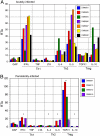Regulatory T cell-like responses in deer mice persistently infected with Sin Nombre virus
- PMID: 17875986
- PMCID: PMC2000535
- DOI: 10.1073/pnas.0707454104
Regulatory T cell-like responses in deer mice persistently infected with Sin Nombre virus
Abstract
Hantavirus cardiopulmonary syndrome is a zoonotic illness associated with a systemic inflammatory immune response, capillary leak, noncardiogenic pulmonary edema, and shock in humans. Cytokines, including TNF, IFN-gamma, and lymphotoxin, are thought to contribute to its pathogenesis. In contrast, infected rodent reservoirs of hantaviruses experience few or no pathologic changes and the host rodent can remain persistently infected for life. Generally, it is unknown why such dichotomous immune responses occur between humans and reservoir hosts. Thus, we examined CD4(+) T cell responses from one such reservoir, the deer mouse (Peromyscus maniculatus), infected with Sin Nombre virus. Proliferation responses to viral nucleocapsid antigen were relatively weak in T cells isolated from deer mice, regardless of acute or persistent infection. The T cells from acutely infected deer mice synthesized a broad spectrum of cytokines, including IFN-gamma, IL-4, IL-5, and TGF-beta(1), but not TNF, lymphotoxin, or IL-17. However, in T cells from persistently infected deer mice, only TGF-beta(1) was expressed by all lines, whereas some expressed reduced levels of IFN-gamma or IL-5. The Forkhead box P3 transcription factor, a marker of some regulatory T cells, was expressed by most of these cells. Collectively, these data suggest that TGF-beta(1)-expressing regulatory T cells may play an important role in limiting immunopathology in the natural reservoir host, but this response may interfere with viral clearance. Such a response may have arisen as a mutually beneficial coadaptive evolutionary event between hantaviruses and their rodent reservoirs, so as to limit disease while also allowing the virus to persist.
Conflict of interest statement
The authors declare no conflict of interest.
Figures




Similar articles
-
Differential lymphocyte and antibody responses in deer mice infected with Sin Nombre hantavirus or Andes hantavirus.J Virol. 2014 Aug;88(15):8319-31. doi: 10.1128/JVI.00004-14. Epub 2014 May 14. J Virol. 2014. PMID: 24829335 Free PMC article.
-
Development and Characterization of a Sin Nombre Virus Transmission Model in Peromyscus maniculatus.Viruses. 2019 Feb 21;11(2):183. doi: 10.3390/v11020183. Viruses. 2019. PMID: 30795592 Free PMC article.
-
Maporal Hantavirus Causes Mild Pathology in Deer Mice (Peromyscus maniculatus).Viruses. 2016 Oct 18;8(10):286. doi: 10.3390/v8100286. Viruses. 2016. PMID: 27763552 Free PMC article.
-
Sin Nombre Virus and the Emergence of Other Hantaviruses: A Review of the Biology, Ecology, and Disease of a Zoonotic Pathogen.Biology (Basel). 2023 Nov 9;12(11):1413. doi: 10.3390/biology12111413. Biology (Basel). 2023. PMID: 37998012 Free PMC article. Review.
-
Hantavirus.Clin Lab Sci. 2003 Winter;16(1):39-42. Clin Lab Sci. 2003. PMID: 12587657 Review.
Cited by
-
Orthohantavirus Pathogenesis and Cell Tropism.Front Cell Infect Microbiol. 2020 Aug 4;10:399. doi: 10.3389/fcimb.2020.00399. eCollection 2020. Front Cell Infect Microbiol. 2020. PMID: 32903721 Free PMC article. Review.
-
Regulatory T cells enhance persistence of the zoonotic pathogen Seoul virus in its reservoir host.Proc Natl Acad Sci U S A. 2007 Sep 25;104(39):15502-7. doi: 10.1073/pnas.0707453104. Epub 2007 Sep 18. Proc Natl Acad Sci U S A. 2007. PMID: 17878294 Free PMC article.
-
Hemorrhagic Fever with Renal Syndrome: Pathogenesis and Clinical Picture.Front Cell Infect Microbiol. 2016 Feb 3;6:1. doi: 10.3389/fcimb.2016.00001. eCollection 2016. Front Cell Infect Microbiol. 2016. PMID: 26870699 Free PMC article. Review.
-
Regulatory T cell-like response to SARS-CoV-2 in Jamaican fruit bats (Artibeus jamaicensis) transduced with human ACE2.PLoS Pathog. 2023 Oct 19;19(10):e1011728. doi: 10.1371/journal.ppat.1011728. eCollection 2023 Oct. PLoS Pathog. 2023. PMID: 37856551 Free PMC article.
-
Pathogen Dose in Animal Models of Hemorrhagic Fever Virus Infections and the Potential Impact on Studies of the Immune Response.Pathogens. 2021 Mar 1;10(3):275. doi: 10.3390/pathogens10030275. Pathogens. 2021. PMID: 33804381 Free PMC article. Review.
References
-
- Mori M, Rothman AL, Kurane I, Montoya JM, Nolte KB, Norman JE, Waite DC, Koster FT, Ennis FA. J Infect Dis. 1999;179:295–302. - PubMed
-
- Ennis FA, Cruz J, Spiropoulou CF, Waite D, Peters CJ, Nichol ST, Kariwa H, Koster FT. Virology. 1997;238:380–390. - PubMed
-
- Kilpatrick ED, Terajima M, Koster FT, Catalina MD, Cruz J, Ennis FA. J Immunol. 2004;172:3297–3304. - PubMed
Publication types
MeSH terms
Substances
Grants and funding
LinkOut - more resources
Full Text Sources
Research Materials

